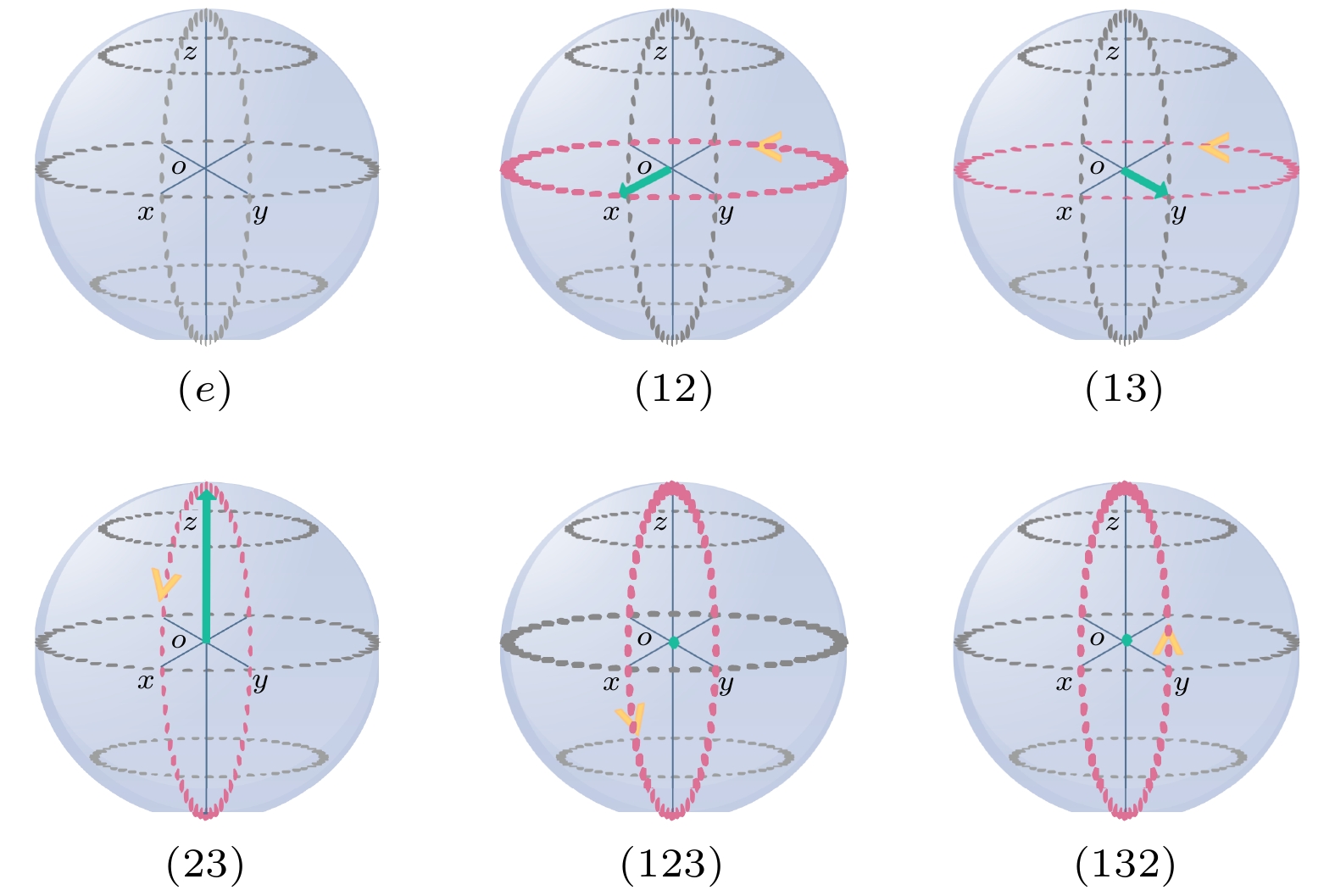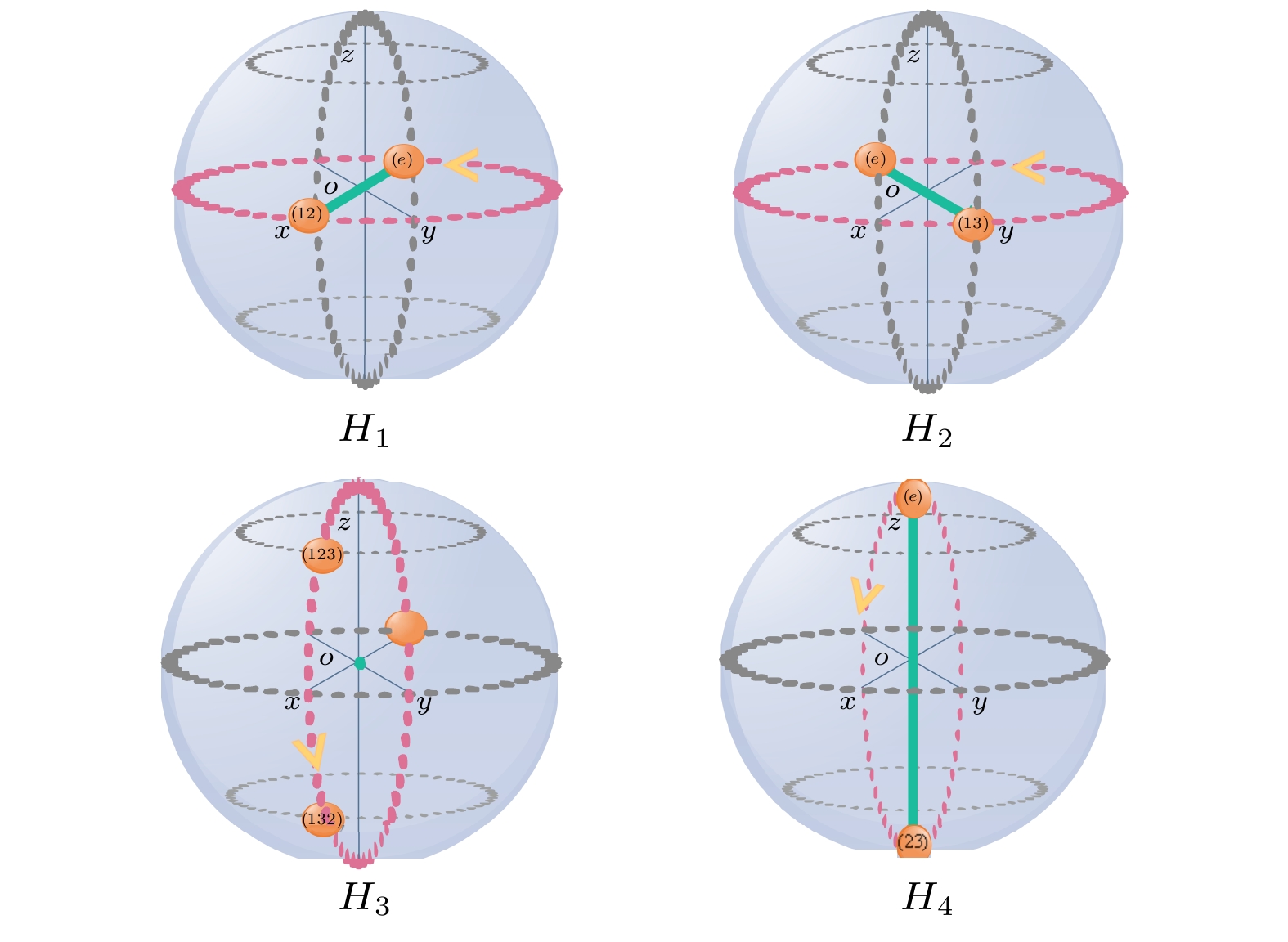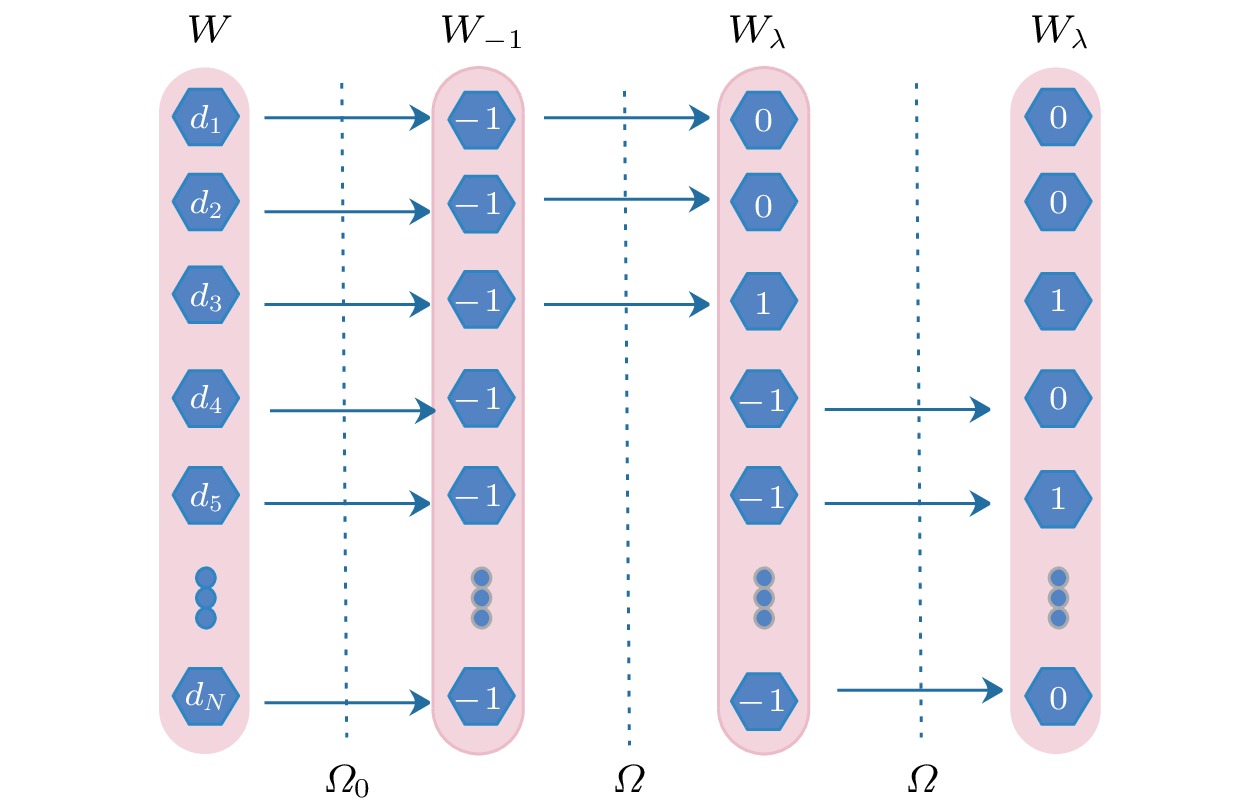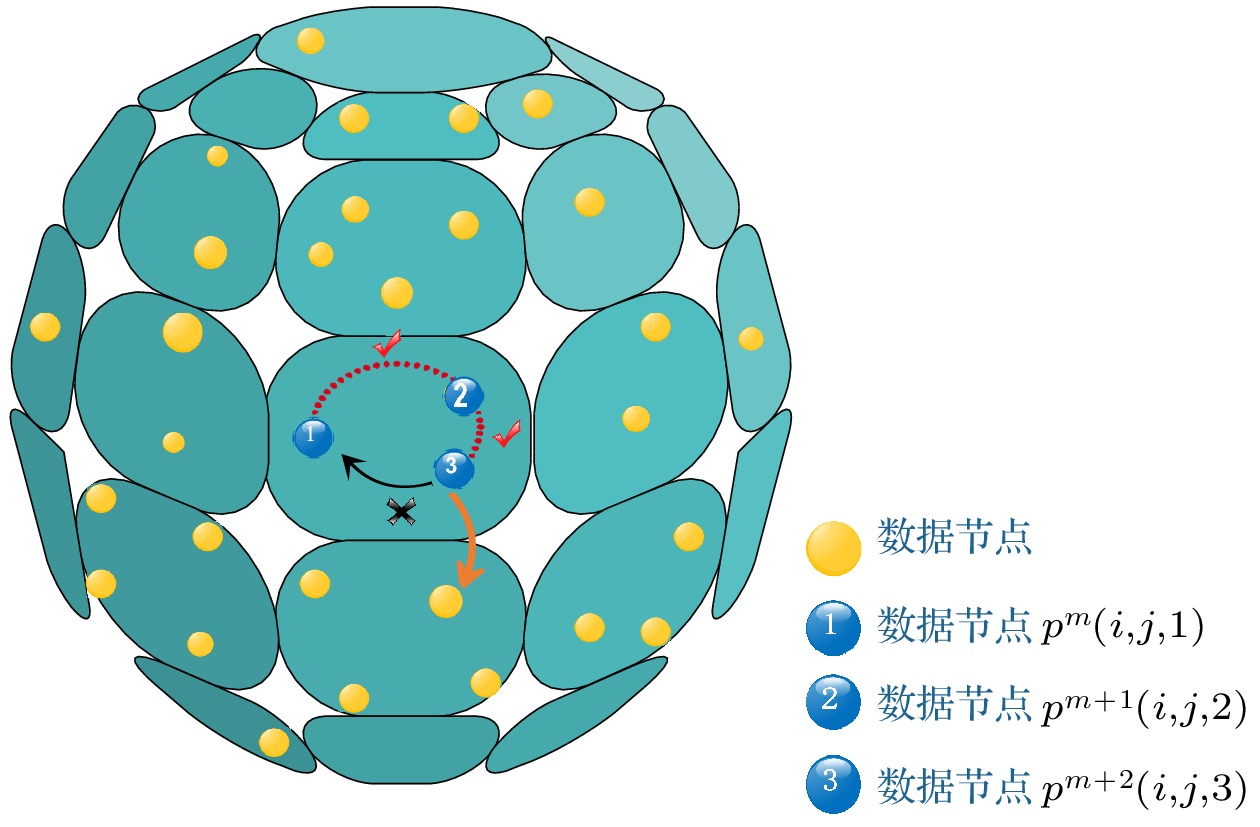-
在量子计算科学中, 如何更好地构建量子搜索算法一直以来受到学者们的广泛关注, 并且基于量子行走寻找新的搜索算法也仍吸引着学者们不断深入研究与探索. 本文从减少搜索过程中的时间消耗、增加算法搜索的准确性和可控性等多方面进行考虑, 提出了一种基于置换群的多粒子量子行走搜索算法. 首先分析得到置换群在空间中可看成一个闭环, 定义了置换集合, 并且通过同构映射将数据点所在数据集映射到定义的置换集, 使得置换集合中元素数据点形成一一对应的关系. 其次, 根据给定初始态和硬币算符, 在数据点集与置换集合张成的搜索空间中利用多粒子的量子行走在环上进行目标数据搜索. 最后, 根据函数
$\varPhi(w)=1$ 找到目标数据, 并用量子态存储数值, 用于形成搜索算法的反馈控制; 同时通过控制硬币算符从而控制量子行走在环上的行走方向, 增加搜索的可操作性与准确性. 本文利用多粒子的量子行走进行搜索, 分析得到粒子数量参数j与时间复杂度呈非线性负相关; 提出的量子行走搜索算法符合零点条件与下确界条件, 且不受变量数j的影响; 通过数值分析得到量子行走搜索算法的时间复杂度等价于$O(\sqrt[^3]{N})$ , 相比于Grover搜索算法提高了搜索效率.In quantum computing science, much attention has been paid to how to construct quantum search algorithms better, moreover, searching for new search algorithms based on quantum walk is still attracting scholars' continuous in-depth research and exploration. In this paper, a multi-particle quantum walk search algorithm based on permutation group is proposed by considering many aspects, such as reducing time consumption and increasing the accuracy and controllability of algorithm search. Firstly, the permutation group can be regarded as a closed loop in space, and the permutation set is defined. The data set of data points is mapped to the defined permutation set by isomorphism mapping, which makes the element data points in the permutation set form a one-to-one correspondence. Secondly, according to the given initial state and coin operator, the target data search is carried out on the ring by using the quantum walk of multiple particles in the search space of the data point set and the permutation set. Finally, the target data is found according to the function$\varPhi(w)=1 $ , and the value is stored by the quantum state, which is used to form the feedback control of the search algorithm. At the same time, the direction of quantum walking on the ring is controlled by controlling the coin operator, thus increasing the operability and accuracy of the search. In this paper, the quantum walk of multiple particles is used to search, and the analysis shows that the particle number parameter j is negatively correlated with the time complexity, but not negatively linear. The proposed quantum walk search algorithm conforms to the zero condition and the lower bound condition, and is not affected by the variable parameter j. Through numerical analysis, it is found that the time complexity of the quantum walk search algorithm is equivalent to$O(\sqrt[3]{N})$ , which improves the search efficiency compared with the Grover search algorithm.-
Keywords:
- search algorithm /
- quantum random walk /
- permutation group /
- isomorphic mapping
[1] Aharonov Y, Luiz D, Nicim Z 1993 Phys. Rev. A 48 1687
 Google Scholar
Google Scholar
[2] Farhi E, Gutmann S 1998 Phys. Rev. A 58 915
 Google Scholar
Google Scholar
[3] Godsil C, Kirkland S, Severini S, Smith J 2012 Phys. Rev. Lett. 109 050502
 Google Scholar
Google Scholar
[4] Bose S 2003 Phys. Rev. Lett. 91 207901
 Google Scholar
Google Scholar
[5] Childs A M 2009 Phys. Rev. Lett. 102 180501
 Google Scholar
Google Scholar
[6] Berry S D, Wang J B 2011 Phys. Rev. A 83 042317
[7] Zähringer F, Kirchmair G, Gerritsma R, Solano E, Blatt R, Roos C F 2010 Phys. Rev. Lett. 104 100503
 Google Scholar
Google Scholar
[8] Ma H Y, Zhang X, Xu P A, Liu F 2020 Wirel. Pers. Commun. 113 2203
 Google Scholar
Google Scholar
[9] Wocjan P, Abeyesinghe A 2008 Phys. Rev. A 78 042336
 Google Scholar
Google Scholar
[10] Orsucci D, Briegel H J, Dunjko V 2018 Quantum 2 105
 Google Scholar
Google Scholar
[11] Chakraborty S, Novo L, Ambainis A, Omar Y 2016 Phys. Rev. Lett. 116 100501
 Google Scholar
Google Scholar
[12] Chakraborty S, Novo L, Di Giorgio S, Omar Y 2017 Phys. Rev. Lett. 119 220503
 Google Scholar
Google Scholar
[13] Chang C R, Lin Y C, Chiu K L, Huang T W 2020 AAPPS Bull. 30 9
 Google Scholar
Google Scholar
[14] Childs A M 2010 Commun. Math. Phys. 294 581
 Google Scholar
Google Scholar
[15] Shenvi N, Kempe J, Whaley K B 2003 Phys. Rev. A 67 052307
 Google Scholar
Google Scholar
[16] Sansoni L, Sciarrino F, Vallone G, Mataloni P, Crespi A, Ramponi R, Osellame R 2012 Phys. Rev. Lett. 108 010502
 Google Scholar
Google Scholar
[17] Caruso F 2014 New J. Phys. 16 055015
 Google Scholar
Google Scholar
[18] Liu F, Zhang X, Xu P A, He Z X, Ma H Y 2020 Int. J. Theor. Phys. 59 3491
 Google Scholar
Google Scholar
[19] Dunjko V, Briegel H J 2015 New J. Phys. 17 073004
 Google Scholar
Google Scholar
[20] Glos A, Krawiec A, Kukulski R, PuchaPuchała Z 2018 Quantum Inf. Process. 17 1
 Google Scholar
Google Scholar
[21] Mülken O, Blumen A 2011 Phys. Rep. 502 37
 Google Scholar
Google Scholar
[22] Long G L, Wang C, Deng F G, Zheng C 2013 Conference on Coherence and Quantum Optics Rochester, New York, USA, June 17–20, 2013 ppM6–42
[23] Kempf A, Portugal R 2009 Phys. Rev. A 79 052317
 Google Scholar
Google Scholar
[24] Zhou L, Sheng Y B, Long G L 2020 Sci. Bull. 65 12
 Google Scholar
Google Scholar
[25] Zhou Z, Sheng Y, Niu P, Yin L, Long G L, Hanzo L 2020 Sci. China: Phys. Mech. Astron. 63 1
 Google Scholar
Google Scholar
[26] Long G L 2001 Phys. Rev. A 64 022307
 Google Scholar
Google Scholar
[27] Zhou N R, Huang L X, Gong L H, Zeng Q W 2020 Quantum Inf. Process. 19 1
 Google Scholar
Google Scholar
[28] Zhou N R, Zhu K N, Zou X F 2019 Ann. Phys. 531 1800520
 Google Scholar
Google Scholar
[29] Zhou N R, Zhu K N, Bi W, Gong L H 2019 Quantum Inf. Process. 18 1
 Google Scholar
Google Scholar
[30] Li H H, Gong L H, Zhou N R 2020 Chin. Phys. B 29 110304
 Google Scholar
Google Scholar
[31] Sheng Y B, Zhou L 2018 Phys. Rev. A 98 052343
 Google Scholar
Google Scholar
[32] Sheng Y B, Zhou L 2017 Sci. Bull. 62 1025
 Google Scholar
Google Scholar
[33] 张禾瑞 1997 近世代数基础 (修订本) (北京: 高等教育出版社) 第50页
Zhang H R 1997 Base of Recent Generations (Vol. 19) (Beijing: Higher Education Press) p50 (in Chinese)
[34] Schreiber A, Cassemiro K N, Potoček V, Gábris A, Mosley P J, Andersson E, Jex I, Silberhorn Ch 2010 Phys. Rev. Lett. 104 050502
 Google Scholar
Google Scholar
[35] Diaconis P, Rockmore D 1990 J. Am. Math. Soc. 3 297
 Google Scholar
Google Scholar
[36] Toyama F M, Van Dijk W, Nogami Y 2013 Quantum Inf. Process. 12 p1897
 Google Scholar
Google Scholar
-
表 1 置换集合元素分布情况
Table 1. Distribution of the elements in permutation set.
子群 子群族 群内所在元素 $H_{1}$ $H_{1}^{1}$ $p(1, 1, 1), \; p(1, 1, 2)$ $\vdots$ $\vdots$ $H_{1}^{j_{1}}$ $p(1, j_{1}, 1)$, $p(1, j_{1}, 2)$ $H_{i}$ $H_{i}^{1}$ $p(i, 1, 1), \; p(i, 1, 2)$ $\vdots$ $\vdots$ $H_{i}^{j_{i}}$ $p(i, j_{i}, 1)$, $p(i, j_{i}, 2)$ 表 2 数据仿真结果
Table 2. Numerical simulation results.
数据点数量N $ j = 1 $ $ j = 2$ $ j = 3 $ 1024 3 2 1 2048 4 2 2 4096 4 2 2 8192 6 3 2 16384 7 4 3 32768 8 4 3 -
[1] Aharonov Y, Luiz D, Nicim Z 1993 Phys. Rev. A 48 1687
 Google Scholar
Google Scholar
[2] Farhi E, Gutmann S 1998 Phys. Rev. A 58 915
 Google Scholar
Google Scholar
[3] Godsil C, Kirkland S, Severini S, Smith J 2012 Phys. Rev. Lett. 109 050502
 Google Scholar
Google Scholar
[4] Bose S 2003 Phys. Rev. Lett. 91 207901
 Google Scholar
Google Scholar
[5] Childs A M 2009 Phys. Rev. Lett. 102 180501
 Google Scholar
Google Scholar
[6] Berry S D, Wang J B 2011 Phys. Rev. A 83 042317
[7] Zähringer F, Kirchmair G, Gerritsma R, Solano E, Blatt R, Roos C F 2010 Phys. Rev. Lett. 104 100503
 Google Scholar
Google Scholar
[8] Ma H Y, Zhang X, Xu P A, Liu F 2020 Wirel. Pers. Commun. 113 2203
 Google Scholar
Google Scholar
[9] Wocjan P, Abeyesinghe A 2008 Phys. Rev. A 78 042336
 Google Scholar
Google Scholar
[10] Orsucci D, Briegel H J, Dunjko V 2018 Quantum 2 105
 Google Scholar
Google Scholar
[11] Chakraborty S, Novo L, Ambainis A, Omar Y 2016 Phys. Rev. Lett. 116 100501
 Google Scholar
Google Scholar
[12] Chakraborty S, Novo L, Di Giorgio S, Omar Y 2017 Phys. Rev. Lett. 119 220503
 Google Scholar
Google Scholar
[13] Chang C R, Lin Y C, Chiu K L, Huang T W 2020 AAPPS Bull. 30 9
 Google Scholar
Google Scholar
[14] Childs A M 2010 Commun. Math. Phys. 294 581
 Google Scholar
Google Scholar
[15] Shenvi N, Kempe J, Whaley K B 2003 Phys. Rev. A 67 052307
 Google Scholar
Google Scholar
[16] Sansoni L, Sciarrino F, Vallone G, Mataloni P, Crespi A, Ramponi R, Osellame R 2012 Phys. Rev. Lett. 108 010502
 Google Scholar
Google Scholar
[17] Caruso F 2014 New J. Phys. 16 055015
 Google Scholar
Google Scholar
[18] Liu F, Zhang X, Xu P A, He Z X, Ma H Y 2020 Int. J. Theor. Phys. 59 3491
 Google Scholar
Google Scholar
[19] Dunjko V, Briegel H J 2015 New J. Phys. 17 073004
 Google Scholar
Google Scholar
[20] Glos A, Krawiec A, Kukulski R, PuchaPuchała Z 2018 Quantum Inf. Process. 17 1
 Google Scholar
Google Scholar
[21] Mülken O, Blumen A 2011 Phys. Rep. 502 37
 Google Scholar
Google Scholar
[22] Long G L, Wang C, Deng F G, Zheng C 2013 Conference on Coherence and Quantum Optics Rochester, New York, USA, June 17–20, 2013 ppM6–42
[23] Kempf A, Portugal R 2009 Phys. Rev. A 79 052317
 Google Scholar
Google Scholar
[24] Zhou L, Sheng Y B, Long G L 2020 Sci. Bull. 65 12
 Google Scholar
Google Scholar
[25] Zhou Z, Sheng Y, Niu P, Yin L, Long G L, Hanzo L 2020 Sci. China: Phys. Mech. Astron. 63 1
 Google Scholar
Google Scholar
[26] Long G L 2001 Phys. Rev. A 64 022307
 Google Scholar
Google Scholar
[27] Zhou N R, Huang L X, Gong L H, Zeng Q W 2020 Quantum Inf. Process. 19 1
 Google Scholar
Google Scholar
[28] Zhou N R, Zhu K N, Zou X F 2019 Ann. Phys. 531 1800520
 Google Scholar
Google Scholar
[29] Zhou N R, Zhu K N, Bi W, Gong L H 2019 Quantum Inf. Process. 18 1
 Google Scholar
Google Scholar
[30] Li H H, Gong L H, Zhou N R 2020 Chin. Phys. B 29 110304
 Google Scholar
Google Scholar
[31] Sheng Y B, Zhou L 2018 Phys. Rev. A 98 052343
 Google Scholar
Google Scholar
[32] Sheng Y B, Zhou L 2017 Sci. Bull. 62 1025
 Google Scholar
Google Scholar
[33] 张禾瑞 1997 近世代数基础 (修订本) (北京: 高等教育出版社) 第50页
Zhang H R 1997 Base of Recent Generations (Vol. 19) (Beijing: Higher Education Press) p50 (in Chinese)
[34] Schreiber A, Cassemiro K N, Potoček V, Gábris A, Mosley P J, Andersson E, Jex I, Silberhorn Ch 2010 Phys. Rev. Lett. 104 050502
 Google Scholar
Google Scholar
[35] Diaconis P, Rockmore D 1990 J. Am. Math. Soc. 3 297
 Google Scholar
Google Scholar
[36] Toyama F M, Van Dijk W, Nogami Y 2013 Quantum Inf. Process. 12 p1897
 Google Scholar
Google Scholar
计量
- 文章访问数: 7539
- PDF下载量: 215
- 被引次数: 0




















 下载:
下载:









